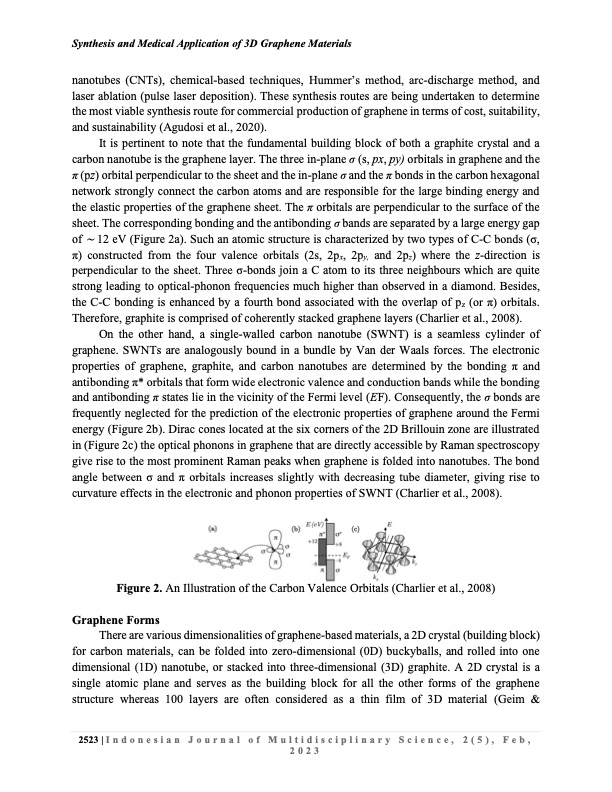PDF Publication Title:
Text from PDF Page: 004
Synthesis and Medical Application of 3D Graphene Materials nanotubes (CNTs), chemical-based techniques, Hummer’s method, arc-discharge method, and laser ablation (pulse laser deposition). These synthesis routes are being undertaken to determine the most viable synthesis route for commercial production of graphene in terms of cost, suitability, and sustainability (Agudosi et al., 2020). It is pertinent to note that the fundamental building block of both a graphite crystal and a carbon nanotube is the graphene layer. The three in-plane σ (s, px, py) orbitals in graphene and the π (pz) orbital perpendicular to the sheet and the in-plane σ and the π bonds in the carbon hexagonal network strongly connect the carbon atoms and are responsible for the large binding energy and the elastic properties of the graphene sheet. The π orbitals are perpendicular to the surface of the sheet. The corresponding bonding and the antibonding σ bands are separated by a large energy gap of ∼ 12 eV (Figure 2a). Such an atomic structure is characterized by two types of C-C bonds (σ, π) constructed from the four valence orbitals (2s, 2px, 2py, and 2pz) where the z-direction is perpendicular to the sheet. Three σ-bonds join a C atom to its three neighbours which are quite strong leading to optical-phonon frequencies much higher than observed in a diamond. Besides, the C-C bonding is enhanced by a fourth bond associated with the overlap of pz (or π) orbitals. Therefore, graphite is comprised of coherently stacked graphene layers (Charlier et al., 2008). On the other hand, a single-walled carbon nanotube (SWNT) is a seamless cylinder of graphene. SWNTs are analogously bound in a bundle by Van der Waals forces. The electronic properties of graphene, graphite, and carbon nanotubes are determined by the bonding π and antibonding π* orbitals that form wide electronic valence and conduction bands while the bonding and antibonding π states lie in the vicinity of the Fermi level (EF). Consequently, the σ bonds are frequently neglected for the prediction of the electronic properties of graphene around the Fermi energy (Figure 2b). Dirac cones located at the six corners of the 2D Brillouin zone are illustrated in (Figure 2c) the optical phonons in graphene that are directly accessible by Raman spectroscopy give rise to the most prominent Raman peaks when graphene is folded into nanotubes. The bond angle between σ and π orbitals increases slightly with decreasing tube diameter, giving rise to curvature effects in the electronic and phonon properties of SWNT (Charlier et al., 2008). Figure 2. An Illustration of the Carbon Valence Orbitals (Charlier et al., 2008) Graphene Forms There are various dimensionalities of graphene-based materials, a 2D crystal (building block) for carbon materials, can be folded into zero-dimensional (0D) buckyballs, and rolled into one dimensional (1D) nanotube, or stacked into three-dimensional (3D) graphite. A 2D crystal is a single atomic plane and serves as the building block for all the other forms of the graphene structure whereas 100 layers are often considered as a thin film of 3D material (Geim & 2523|Indonesian Journal of Multidisciplinary Science, 2(5), Feb, 2023PDF Image | Medical Application of 3D Graphene

PDF Search Title:
Medical Application of 3D GrapheneOriginal File Name Searched:
SYNTHESIS-MEDICAL-APP-3D-GRAPHENE.pdfDIY PDF Search: Google It | Yahoo | Bing
Salgenx Redox Flow Battery Technology: Power up your energy storage game with Salgenx Salt Water Battery. With its advanced technology, the flow battery provides reliable, scalable, and sustainable energy storage for utility-scale projects. Upgrade to a Salgenx flow battery today and take control of your energy future.
CONTACT TEL: 608-238-6001 Email: greg@infinityturbine.com (Standard Web Page)